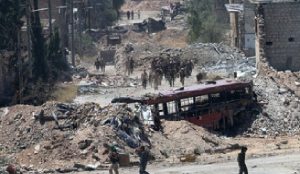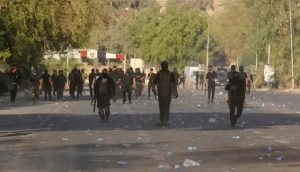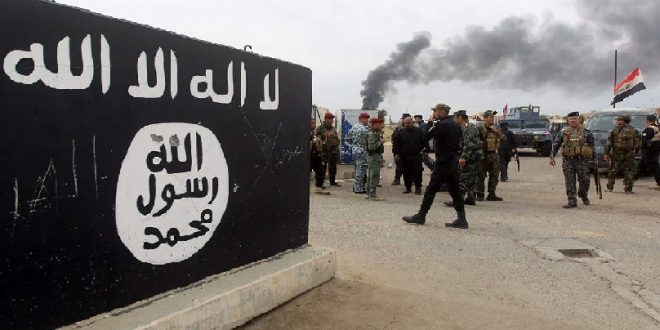15-07-2024
BAGHDAD: Four police officers were killed and at least three injured in clashes between Iraqi government forces and Islamic State (IS) also known as (ISIS/ ISIL or Daesh) militants in Diyala province in eastern Iraq on Saturday, police and medical sources said.
 The clashes occurred while police and army forces conducted a search for militants taking shelter in farmland areas in the town of Khan Bani Saad in Diyala province, police sources said. Two police colonels said the clashes were ongoing and militants are using snipers to prevent police and soldiers from advancing.
The clashes occurred while police and army forces conducted a search for militants taking shelter in farmland areas in the town of Khan Bani Saad in Diyala province, police sources said. Two police colonels said the clashes were ongoing and militants are using snipers to prevent police and soldiers from advancing.
One of at least three police injured was in critical condition, police said.
Iraq’s security situation has been relatively stable in recent years after the chaos of the 2003-US-led invasion and years of bloody sectarian conflict that followed.
Baghdad is now looking to draw down the US-led international coalition that helped defeat Islamic State and still remain in the country in an advisory role, saying local security forces can handle the threat themselves.
ISIS is a Salafi-jihadist group that has conducted and inspired terrorist attacks worldwide, resulting in thousands killed or injured. In 2004, an Iraqi extremist network led by Abu Musab al-Zarqawi merged with al-Qa‘ida to form ISIS’s predecessor group, al-Qa‘ida in Iraq (AQI), which Zarqawi led until his death in 2006. Now-deceased amir Abu Bakr al-Baghdadi took over the group in 2010 and began to expand its operations into eastern Syria in 2011. In 2013, AQI changed its name to ISIS; and in 2014, the group separated from al-Qa‘ida, declared itself a caliphate, and took over vast swaths of territory in Iraq and Syria.
 In 2019, an international coalition ejected ISIS from its last stronghold in Syria, although the group continues to operate clandestinely there and in Iraq. Despite losing many of its leaders and its territory, ISIS remains capable of conducting insurgent operations in Iraq and Syria while overseeing at least 19 branches and networks in Africa, Asia, and Europe. Some of ISIS’s most prominent branches and networks are detailed in separate entries on this site.
In 2019, an international coalition ejected ISIS from its last stronghold in Syria, although the group continues to operate clandestinely there and in Iraq. Despite losing many of its leaders and its territory, ISIS remains capable of conducting insurgent operations in Iraq and Syria while overseeing at least 19 branches and networks in Africa, Asia, and Europe. Some of ISIS’s most prominent branches and networks are detailed in separate entries on this site.
ISIS uses targeted killings, IED attacks, ambushes, military-style assaults, kidnappings, and suicide attacks in Iraq and Syria. The group also encourages adherents worldwide to conduct operations in their own countries using readily available weapons, and it has previously deployed operatives abroad to execute attacks. ISIS mostly attacks military targets and civilian defense forces in Iraq and Syria. The group also frequently targets government personnel and infrastructure, in addition to foreign aid workers and civilians who ISIS perceives are working against it or are opposed to its interpretation of Islamic law.
The US State Department designated AQI, ISIS’s predecessor, as a foreign terrorist organization in December 2004, a designation that remains in effect for ISIS. Several ISIS leaders have also been named Specially Designated Global Terrorists, including former leaders Hajji ‘Abdallah in 2020, Abu Bakr al-Baghdadi in 2011, and Abu Musab al-Zarqawi in 2003.
At its height, the Islamic State held about a third of Syria and 40 percent of Iraq. By December 2017 it had lost 95 percent of its territory, including its two biggest properties, Mosul, Iraq’s second largest city, and the northern Syrian city of Raqqa, its nominal capital. The following is a timeline of the rise, spread and and fall of the Islamic State. The group changed its name to the Islamic State of Iraq and Syria (ISIS) in 2013. ISIS launched an offensive on Mosul and Tikrit in June 2014. On June 29, ISIS leader Abu Bakr al Baghdadi announced the formation of a caliphate stretching from Aleppo in Syria to Diyala in Iraq, and renamed the group the Islamic State. (Int’l Monitoring Desk)
 Pressmediaofindia
Pressmediaofindia




